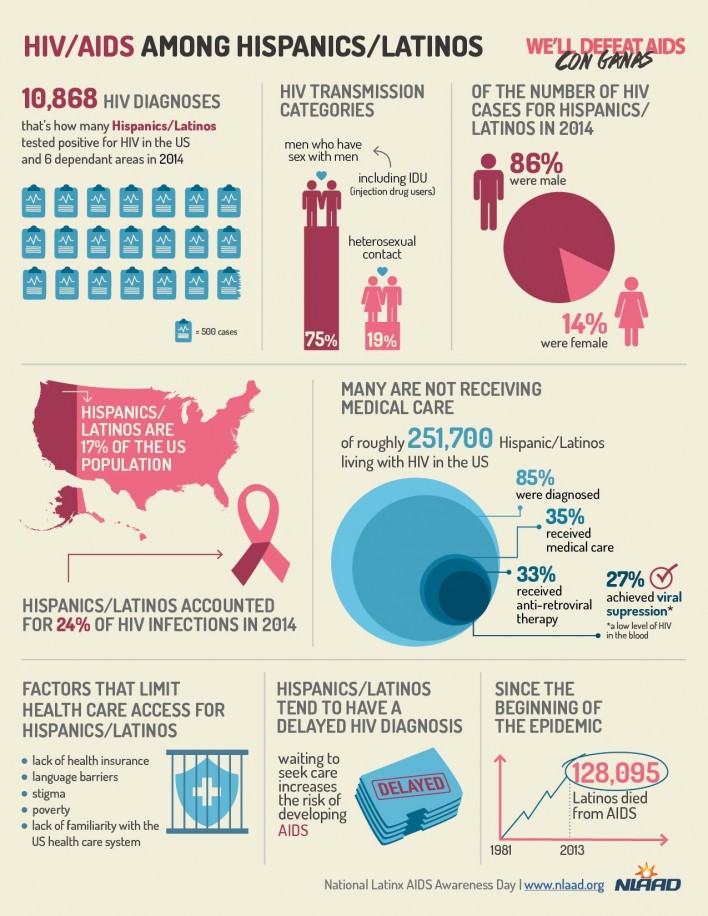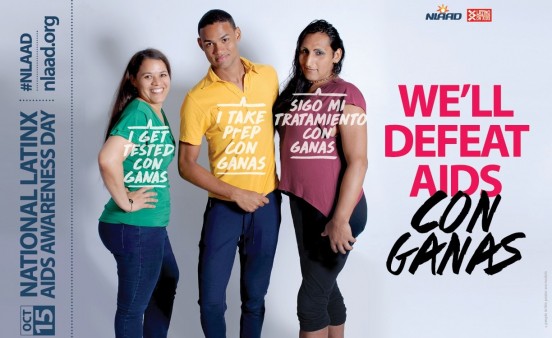Every year, at the end of National Hispanic Heritage Month, to celebrate the histories, cultures and contributions of people living in the U.S. whose ancestors came from Spain and Latin America, we commemorate National Latinx AIDS Awareness Day (NLAAD). It is marked each year on October 15.
This is the first year that Latinx is in the official NLAAD title, replacing Latino. Latinx (pronounced “La-teen-ex”) is a gender-neutral alternative to Latino and Latina.
It’s important to understand the diversity of Latinos/Hispanics in the US who come from Spanish and Portuguese speaking nations, where other languages are also spoken: Mixtec-Zapotec, Mayan, Guarani, Quechua and Aymara, among many others. In 2000, a full decade before predicted, Latinos became the largest minority group in the US – over 13% of the population, and it’s estimated that Latinos/Hispanics now represent 18% of the US population. There is no single system of races or ethnicities that covers all of Latin America, and usage of labels such as “mestizo,” a person of mixed race, may vary substantially. In Mexico, for example, the category “mestizo “is not defined or applied the same as the corresponding category as in Brazil. The ethnic and racial composition of Latinos combines diverse indigenous populations, with influence from Spain and Portugal, equally diverse African groups brought to the Americas as slave labor, and immigrant groups from all over the world including sizeable migration from Japan and China.
Latinos are overrepresented among the poor, making up 28.1% of the more than 45 million poor Americans and 37% of the 14.5 million children in poverty. Socioeconomic factors, such as poverty, homelessness, employment opportunity and unemployment, education level, language barriers, incarceration, immigration status, low-wage jobs, mental health, substance use, insurance coverage and a lack of familiarity with the U.S. Health Care System greatly impact the health care access and prevention/treatment needs of Latinos in the U.S. Cultural issues such as the diversity of race and/or country of origin among Latinos in the U.S., presents nuances that must be considered when serving this community. The racial historical, social, economic, and political differences affect health care experiences and access. Providers must avoid the stereotype of “the Latino patient” and base their treatment approach on specific medical needs and cultural background.
(continued below)

Graphics for National Latinx AIDS Awardness Day 2016 can be downloaded on NLAAD.org.nlaad.org
HIV/AIDS stigma among Latinos is multilayered and perpetuates the HIV epidemic as stigma can contribute to lower screening rates for HIV, and consequently late testing for HIV, than other racial/ethnic groups in the U.S. Among Latinos, both HIV and the behaviors associated with it are highly stigmatized. Latinos with HIV often refer to HIV as “la condicion”, (the condition) and themselves as “pacientes como nosotros” (patients like us), instead of using the term “VIH“ (HIV) or “pacientes que son positivos” (patients who are positive). The lack of culturally appropriate health care and targeted HIV education, economic difficulties, fear of deportation, and a perceived low HIV risk combine to leave Latinos at high risk of HIV. Although the time between untreated HIV infection to an AIDS diagnosis is generally agreed to be 10 to 12 years, 65% of Latinos are diagnosed with AIDS within one year of their HIV diagnosis.
Despite current HIV screening and prevention efforts in the U.S., the HIV epidemic disproportionately impacts Latinos. Hispanics/Latinos represent about 17% of the US population, yet account for approximately 23% of HIV infections. Given that Hispanics/Latinos are the largest and fastest growing minority group in the U.S. with an estimated population of 55 million, addressing HIV/AIDS is important to the nation’s health. Current national statistics show approximately 250,000 Hispanics/Latinos living with HIV in the U.S. Estimates also show that 1 in 36 Hispanic/Latino men and 1 in 106 Hispanic/Latino women will be diagnosed with HIV at some point in their lifetime. These rates vary for Hispanics/Latinos based on place of birth and region; recent data shows that diagnosed HIV cases by place of birth are predominately non-US-born (60%).
Understanding that a large number of Latinos diagnosed with HIV are foreign-born, we need to learn to communicate with patients from different cultures and countries of origin. In addition to collecting information on a client’s health, we need to ask about a client’s cultural background. There are multiple models but in The Latino Patient, Nilda Chong proposes using the GREET model when working with Latinos: Generation, Reasons for Immigrating, Extended or Nuclear Family, Ethnic Behavior, and Time in the U.S. This model provides an opportunity to collect cultural information and demonstrate interest in the lives of their Latino clients, establishing confianza (trust).
National Latinx AIDS Awareness Day is a community mobilization and awareness initiative led by the Latino Commission on AIDS that is meant to create awareness about the impact of HIV in Latino communities, HIV Testing, PrEP, HIV treatment and care. It is also an opportunity to educate Latino and non-Latino communities around our diversity and shared values, stigma, discrimination, homophobia, transphobia, and all of the social determinants that impact our health. A holistic approach to address HIV is extremely important if we are to reduce HIV and treatment differences among Latinos, and improve healthcare and health status for all.








Comments
Comments